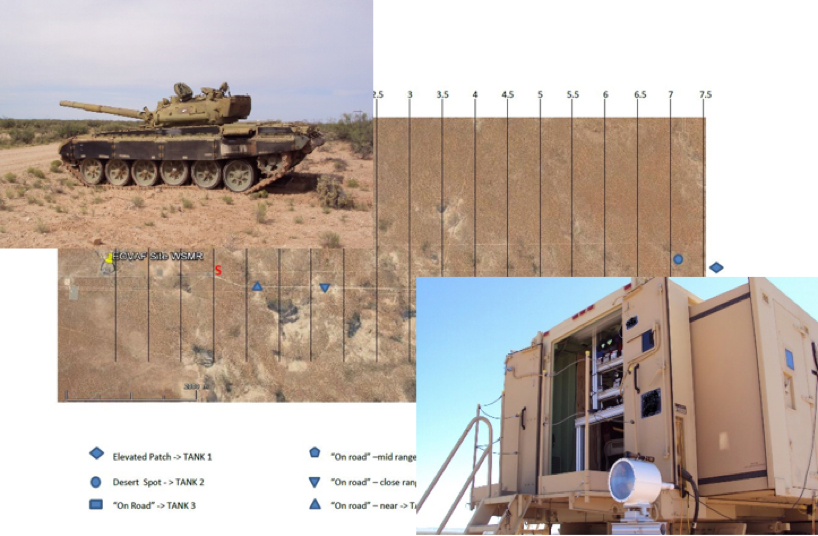 Impression of SET-234 field trial. From top to bottom: T-72 tank, spatial test configuration and sensor system setup. Impression of SET-234 field trial. From top to bottom: T-72 tank, spatial test configuration and sensor system setup.A TDA (Tactical Decision Aid) predicts windows of opportunity or denial for military operations, based on predicted weather conditions. Local conditions such as weather, geographic location, and terrain influence the detectability or recognizability of a given target. The TDA can, for example, identify time periods when the opponent's sensor has a shorter detection range than your own, a clear advantage.
SET-234 studied the relation between the environment and the performance of Electro-Optical or EO-TDAs, with the aim to characterize the variability in performance, to provide advice on mitigating adverse weather effects or alternatively, to exploit environmental effects to gain a tactical advantage in theatre.
Existing EO-TDAs differ widely in appearance and products, as they are designed to respond to specific mission planner requests for different contexts of operation. Nevertheless, they share the elements of the target task chain (geophysical environment, target, propagation, sensor, decision process) necessary and sufficient for reliable EO-TDA performance modelling.
To succeed in its mission, SET-234 created a working group on CUBI, a simple L-shaped proxy for a target, to study its behaviour under a great variety of climatic conditions. Legacy data was gathered in a database, and new data acquired in different climatic regions were added, thereby creating an unclassified tool for comparing the performance of different EO-TDAs. Modelling of CUBI surface temperatures has resulted in mostly accurate results, although details still need to be worked out.
SET-234 held a field trial at White Sands Missile Range (NM, USA), to generate a comprehensive set of test data in a warm, desert-like environment. In this trial (supported by CSO), military targets were used, such as T72 tanks and ZIL-131 trucks.
SET-234 concluded that the current detection, classification and identification algorithms are not robust against all environmental scenarios that may be encountered in the operational theatre.
All Nations participating in SET-234 either have a fielded EO-TDA or are in the process of fielding or developing an EO-TDA. Since these EO-TDAs are dedicated to different tasks, the progress made by individual Nations differs for specific elements of the target task chain. The discussions and exchanges within SET-234 allow each Nation to benefit from the stronger elements within the other Nations.
SET-234 provides guidance for EO-TDA developers within NATO, Allied Nations and Partner Nations. The Nations participating in SET-234 have used the results to improve National Capabilities. This will ultimately integrate the effect of the environment in short-term mission planning and the assessment of the probability of mission accomplishment.
Electro-optical Tactical Decision Aids (EO-TDAs) provide a measure for in-theatre task accomplishment of friendly and hostile electro-optical sensors by assessing the complete observation chain. However, the necessary and sufficient fidelity of target characterization and target task metrics such as DRI to achieve a reliable TDA outcome is not yet clear. In this respect, a future assessment of the TDA sensitivity against these parameters is desirable. Published by SET | 